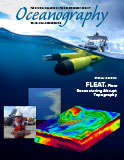Article Abstract
This paper focuses on the representation of damping of mesoscale eddies, currents, and tides in global ocean models by the topographic wave drag they generate over bathymetric features. Insertion of parameterized topographic wave drag into global high-resolution models strongly impacts the energy budget, near-bottom stratification, near-bottom velocities, and vertical structure of low-frequency mesoscale eddies and currents, and impacts the low-frequency surface kinetic energy and sea surface height variance to a measurable (though lesser) extent. Parameterized topographic wave drag also strongly impacts the amplitudes of tidal motions. Process modeling studies show great potential to improve existing topographic wave drag parameterizations, although much more work is needed to develop a complete understanding of the full parameter space needed to develop practical implementations for global ocean models.

